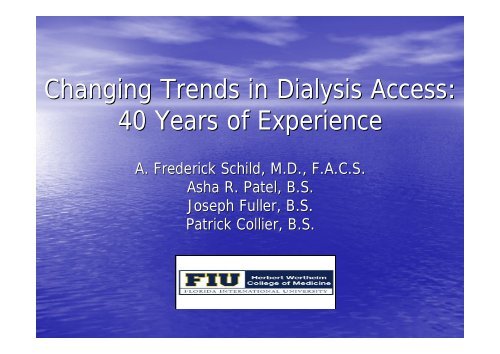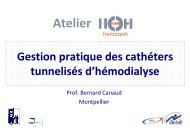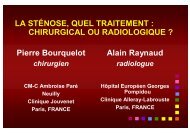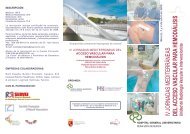W32a Schild 40 Years of Experience Final Revised.ppt ... - SFAV
W32a Schild 40 Years of Experience Final Revised.ppt ... - SFAV
W32a Schild 40 Years of Experience Final Revised.ppt ... - SFAV
Create successful ePaper yourself
Turn your PDF publications into a flip-book with our unique Google optimized e-Paper software.
Changing Trends in Dialysis Access:<br />
<strong>40</strong> <strong>Years</strong> <strong>of</strong> <strong>Experience</strong><br />
A. Frederick <strong>Schild</strong>, M.D., F.A.C.S.<br />
Asha R. Patel, B.S.<br />
Joseph Fuller, B.S.<br />
Patrick Collier, B.S.
History<br />
• Hemodialysis was first carried out on<br />
humans in Holland by Dr. Willem Kolff<br />
during WWII.<br />
• Soon afterward, Dr. Kolff came to the<br />
United States to share his discoveries from<br />
his experiments.<br />
Uribarri J. Past, Present and Future <strong>of</strong> ESRD Therapy in the United States. Mount Sinai Journal <strong>of</strong> Medicine 66(1): 14-19,<br />
Jan 1999.
Scribner Shunt<br />
•The external<br />
arteriovenous shunt<br />
described by Quinton,<br />
Dillard, and Scribner in<br />
1960 led to the<br />
establishment <strong>of</strong> chronic<br />
hemodialysis.<br />
Bennion RS and Wilson SE. Chapter 34: Hemodialysis and Vascular Access. Vascular Surgery: A Comprehensive Review. Sixth<br />
Edition. Philadelphia, W.B. Saunders Company, 2002, Page 652.
Arteriovenous Fistula<br />
• In 1966, Brescia, Cimino, and Appel<br />
surgically created an anastamosis between<br />
the radial artery and cephalic vein in the<br />
wrist.<br />
• Within a decade <strong>of</strong> its creation, the internal<br />
arteriovenous fistula replaced the external<br />
shunt as the preferred mode <strong>of</strong> vascular<br />
access.<br />
• Today, KDOQI recommends at least 66% <strong>of</strong> all<br />
vascular access procedures be arteriovenous<br />
fistulae.<br />
Ronco, C and Levin NW (eds): Hemodialysis, Vascular Access, and Peritoneal Dialysis Access. Contrib Nephrol.<br />
Basel, Karger, 2004, vol 142, pp 1-13.
AV Grafts<br />
• Saphenous veins were also used in the<br />
1970’s s and 1980’s, however, they tend<br />
to have poor outcomes.<br />
• PTFE grafts were introduced in 1973.<br />
– Now it is the most commonly used<br />
artificial material for vascular grafts in<br />
hemodialysis.<br />
Ronco, C and Levin NW (eds): Hemodialysis, Vascular Access, and Peritoneal Dialysis Access. Contrib Nephrol. Basel,<br />
Karger, 2004, vol 142, pp 1-13.
Double-lumen lumen Catheter<br />
• In 1980, a double-lumen lumen cuffed catheter was<br />
designed to be placed in the internal jugular<br />
vein and into the superior vena cava.<br />
• Although the catheter has evolved into a better<br />
and safer design, a great risk <strong>of</strong> complications<br />
<strong>of</strong> central vein stenosis and infection still exist.<br />
Ronco, C and Levin NW (eds): Hemodialysis, Vascular Access, and Peritoneal Dialysis Access. Contrib Nephrol. Basel,<br />
Karger, 2004, vol 142, pp 1-13.
Conduits for Access<br />
• Over the years, I have had the experience<br />
<strong>of</strong> using a multitude <strong>of</strong> conduits for access<br />
such as:<br />
– Scribner’s s Shunt<br />
– Bovine Grafts<br />
– Autologous Fistulae<br />
– Umbilical Vein Grafts<br />
– PTFE<br />
– Polyetherurethaneurea Grafts.
Vascular Access Requires a<br />
Multidisciplinary Approach
American Medical News<br />
April 21, 2003<br />
•“Patients with chronic illnesses must<br />
navigate a complex regimen <strong>of</strong> multiple<br />
physicians and medications. Coordination <strong>of</strong><br />
the medical team supports patients by<br />
improving care and avoiding<br />
hospitalizations.”<br />
•Therefore, a structured and well organized<br />
multidisciplinary team approach appears to<br />
be the most practical and efficient way to<br />
achieve quality care for ESRD patients.
The Multidisciplinary Approach<br />
• Patients who have earlier access to surgeons<br />
– Higher incidence <strong>of</strong> an AVF because veins are<br />
not destroyed<br />
– Decreased use <strong>of</strong> temporary catheters<br />
• Complications are identified and corrected in a<br />
timely fashion, including:<br />
– Increased long-term patency<br />
– Less hospitalizations<br />
– Less repeat surgery
Participating Specialties<br />
• Primary Care Physicians<br />
• Nephrologists<br />
• Interventional Nephrologists<br />
• Interventional Radiologists<br />
• Anesthesiologists<br />
• Surgeons<br />
• Nurse Coordinator
Epidemiology<br />
• At the present time, there are<br />
approximately 300,000 patients on<br />
hemodialysis in the United States.<br />
• The number <strong>of</strong> vascular access procedures<br />
is nearing 500,000 per year.<br />
• ESRD is growing by approximately 15%<br />
each year (doubling in 4-64<br />
6 years).<br />
• Total annual costs are projected to exceed<br />
$28 billion by 2010.
Technique for Large Aperture<br />
Anastomosis
Immediately Post-Operative AVF
Advantages <strong>of</strong> AVF<br />
• Reduced infections!<br />
• In our recent study we evaluated 1574<br />
vascular access procedures for infection.<br />
• There were 132 patients operated upon<br />
for access infection.<br />
• Of the 132 patients, only one (1) patient<br />
had an AVF (0.75%).
Disadvantages <strong>of</strong> AVF<br />
• It has been shown that 30-50% <strong>of</strong> all AV<br />
fistulae fail to mature.<br />
• A recent retrospective study by <strong>Schild</strong>, et<br />
al compared 1700 consecutive procedures.<br />
– At 10 years there were no statistically<br />
significant differences between the patency <strong>of</strong><br />
grafts and fistulae.
• Advantages:<br />
AV Grafts<br />
– Newer grafts can be cannulated within 24-72<br />
hours, decreasing double-lumen lumen cuffed catheter<br />
time.<br />
– AV graft revisions have better results than<br />
revised AV fistulae.<br />
– In certain populations grafts are a better<br />
alternative to fistulae.<br />
• Disadvantages:<br />
– Higher infection rate<br />
– Higher rate <strong>of</strong> thrombosis
Complications <strong>of</strong> Vascular Access:<br />
Central Vein Stenosis
Seroma
Access Thrombectomy<br />
• Thrombosis is the most common complication <strong>of</strong><br />
vascular access.<br />
• AV grafts have higher incidence <strong>of</strong> clotting than<br />
AV fistulae, but have longer post revision<br />
patency.<br />
• Methods <strong>of</strong> access thrombectomy:<br />
– Endovascular with angioplasty and stent<br />
– Surgical revision<br />
• Both methods must focus on removal <strong>of</strong> arterial<br />
plug.
Failure <strong>of</strong> AVFs to Mature:<br />
University <strong>of</strong> Miami Study
Methods<br />
• 373 patients underwent construction <strong>of</strong><br />
AVF as permanent primary access.<br />
• Our criteria and KDOQI requires the vein<br />
and artery to be at least 2.5 mm in<br />
diameter.<br />
• Pre-operative vein mapping was<br />
performed.<br />
• From, this population, 291 patients had<br />
complete follow-up data for at least three<br />
months
Definition <strong>of</strong> Failure<br />
• All early AVF occlusions were considered<br />
failures.<br />
• After construction, if the AVF did not<br />
clinically mature within 3 months, it was<br />
considered a failure.<br />
• Additional failures were identified when<br />
cannulation in the dialysis center could not<br />
be accomplished.
Conclusions<br />
• In our series we placed more AVF in Males<br />
than in Females; despite the fact that<br />
Males and Females present for dialysis at<br />
the same frequency.<br />
• Overall Failure Rate was 31.3%<br />
– Females 41.2%<br />
– Males 27.2%
Conclusions<br />
• Increasing co-morbidity did not result in<br />
major changes in failure rate.<br />
• The brachiocephalic position matured at<br />
a higher frequency than the<br />
radiocephalic.
Questions for Discussion<br />
• In light <strong>of</strong> published AVF Failure Rates<br />
ranging from 20% to 50% are we<br />
submitting patients to an unnecessary<br />
second operation (AVF then prosthetic<br />
access)?<br />
• Should KDOQI Guidelines be revisited in<br />
terms <strong>of</strong> developing more focused criteria<br />
for AVF or should we be more meticulous<br />
in our pre-operative work-up?
Infections associated with<br />
vascular access procedures:<br />
University <strong>of</strong> Miami Study
Infections in Vascular Access<br />
• Infection is the second most common<br />
complication in vascular access.<br />
• Death secondary to infection in dialysis<br />
patients is estimated at 36%.
Methods<br />
• We reviewed the medical records <strong>of</strong> 1574<br />
consecutive vascular procedures<br />
performed on 850 patients, over a 60<br />
month period.<br />
• Infection was diagnosed when there were<br />
local signs <strong>of</strong> inflammation or purulence<br />
requiring intravenous antibiotics and<br />
removal <strong>of</strong> the access.
Methods<br />
• 132 procedures (8%) were performed for<br />
infection in 87 patients.<br />
– 86 infected grafts<br />
– 1 infected AVF<br />
• This occurred two years following access surgery<br />
which was complicated by a pseudo-aneurysm with<br />
skin erosion.
Results<br />
• There were multiple organisms cultured as the<br />
cause <strong>of</strong> infection.<br />
• The two most common were:<br />
– S. aureus (26%)<br />
– MRSA (21%)<br />
• Overall Operative Infection Rate was 0.51% (n<br />
= 1574) .<br />
– Fistulas had no operative infections (n = 521).<br />
– Operative graft infection rate <strong>of</strong> 0.86% (n = 921).
Conclusions<br />
• Infections attributable to access<br />
operations had a low prevalence.<br />
• The largest number <strong>of</strong> infections occurred<br />
in patients undergoing routine dialysis.<br />
– Dialysis centers were responsible for 50% <strong>of</strong><br />
all infections identified.<br />
• This data suggests close observation in<br />
the dialysis center is strongly advised.
Conclusions<br />
• We found 30 grafts (23%) that were non-<br />
functional and dormant for long periods <strong>of</strong><br />
time that ultimately became infected.<br />
• There should be a high index <strong>of</strong> suspicion<br />
for thrombosed grafts as a source <strong>of</strong><br />
bacteremia even in the absence <strong>of</strong> local<br />
signs <strong>of</strong> infections.
Conclusions<br />
• When a graft was removed, it had been<br />
our policy to leave a graft stump at the<br />
arterial anastomosis when the artery<br />
was very small and no vein was<br />
available for a patch.<br />
• 17% <strong>of</strong> these operations for infection<br />
were performed because these stumps<br />
became infected.
Recommendations<br />
• It is recommended when infection is<br />
identified in non-functional grafts they be<br />
removed immediately.<br />
• Delay due to antibiotic therapy is not<br />
warranted as the presence <strong>of</strong> a foreign<br />
body will not allow complete eradication <strong>of</strong><br />
infection with antibiotics alone.
Complications <strong>of</strong> Infection
Complications <strong>of</strong> Infection
Future Developments<br />
• New studies are being conducted to alter the<br />
genes in the vein at the venous anastomosis to<br />
prevent neointimal hyperplasia.<br />
• There is a new graft manufactured by Atrium<br />
Medical Corp. in which cannulation can be<br />
achieved within 24-72 hours.<br />
• This early cannulation prevents prolonged<br />
double-lumen lumen cuffed catheter use, leading to<br />
lower rates <strong>of</strong> stenosis and infection.<br />
– Current clinical trials have shown much success
<strong>Final</strong> Conclusions<br />
• Vascular Access procedures are<br />
becoming the most common surgery<br />
performed in the United States and<br />
around the world.<br />
• Vascular Access should be a<br />
multidisciplinary effort.
<strong>Final</strong> Conclusions<br />
• Vascular Access surgery encompasses<br />
many difficult problems and should<br />
only be performed by those dedicated<br />
to its success.<br />
• A greater effort should be made to<br />
create more arteriovenous fistulae<br />
than prosthetic grafts to comply with<br />
KDOQI guidelines.
THANK YOU







![70 Schild A-F Flixene 4.pptx [Lecture seule] - SFAV](https://img.yumpu.com/26265235/1/190x135/70-schild-a-f-flixene-4pptx-lecture-seule-sfav.jpg?quality=85)





![57 Sessa DRIL.ppt [Lecture seule] - SFAV](https://img.yumpu.com/26265217/1/190x135/57-sessa-drilppt-lecture-seule-sfav.jpg?quality=85)


![06 Mouton FAV Native Bras.ppt [Lecture seule] - SFAV](https://img.yumpu.com/26265208/1/190x135/06-mouton-fav-native-brasppt-lecture-seule-sfav.jpg?quality=85)
